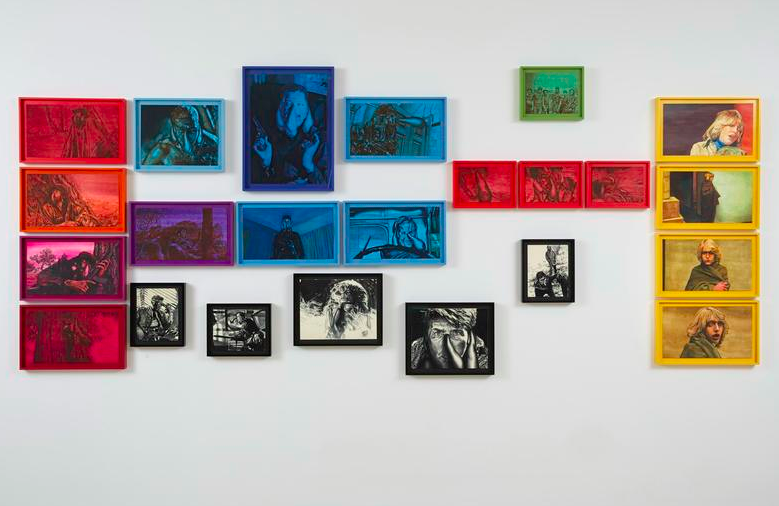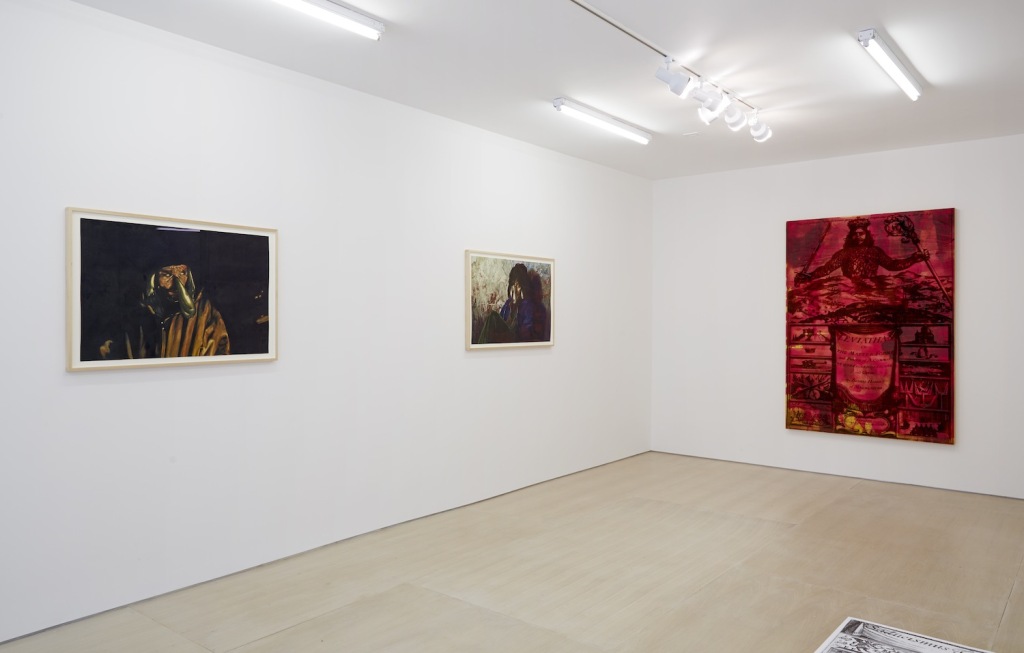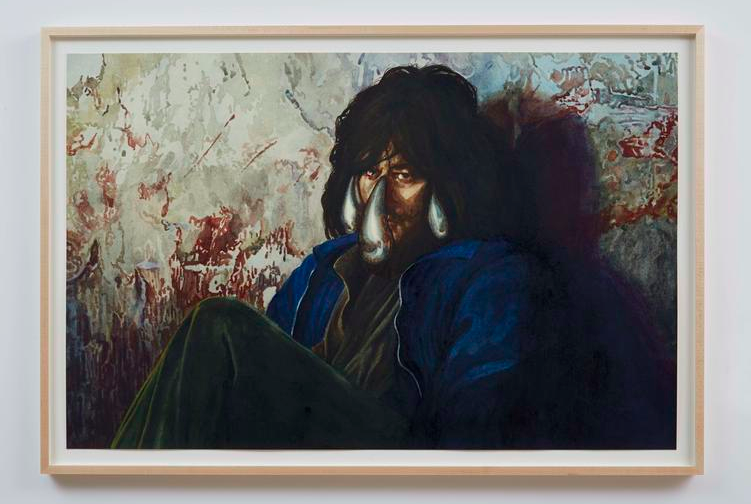
Adam Helms, Untitled (Dante and Beatrice in Technicolor), 2014, Gouache and aniline dye on paper, 23 panels: dimensions variable, Boesky East, Marianne Boesky Gallery, NY, 2014
For the inaugural exhibition at Boesky East, a new downtown space for Marianne Boesky Gallery, artist Adam Helms had his third solo show with the gallery since 2007. Titled, Uncanny Valley the exhibition showcased the artists work and hand with gouache paintings and a flocked digitally carved work on wood panel. Plainly put, Helms has a way with the painted figure. His works on paper are eerie, the subjects existing somewhere between life and death; their expressions both direct and removed. A subtle light dances across creased flesh, however artificial and made from various degrees of opaque and transparent paint. Rather than just paint portraits, Helms has delved into the world of absurdity within magic realism. For most of his subjects in Uncanny Valley, a bulbous shape hangs from each nose and earlobe. The forms are phallic, also resembling the nose of the male proboscis monkey. Paul McCarthy used a similar facial appendages when portraying versions of the Seven Dwarves, in White Snow (2013) -soft, droopy, and emasculating. The unnatural configurations distract the eyes from the features that normally lead to facial recognition. Instead of direct likeness we are presented with a series of faces that have purposely been deformed by the hand of the artist. They are abject yet beautiful in the astuteness of craft. What is it to be absurd? This is a question that the frozen subjects appear to silently pose to the viewer, unaware of their own physical defect. The world within the frame is a time strictly established by the artist and Helms invites us into a dark sphere that in its self-deprecating humor, shimmers with sparks of lightness. Specifically in the larger portraits from this body of work, the paintings are inviting as they are repulsive. Not a common sight to currently find in many contemporary art galleries, human likeness has been knocked down on the scale of painting, replaced by New Abstraction. But paint is magical as a medium appearing in non-narrative forms that emerge in abstract works, as it is forming those small spaces in the nook of an eyelid. The process is metaphysical for the artist in both circumstances and in its purest form, a built up surface will invite a viewer to lean in for a closer look. The question when confronting the depiction of a human subject, is if you as a viewer, are able to return the gaze, indeed a projection from the artist himself, that eternally peers out.

Adam Helms, Uncanny Valley, Installation view at Boesky East, 2014, Photograph courtesy of Marianne Boesky Gallery, NY
A painter interested in figuration will always need a model, photographic reference, a vivid imagination or astute memory to employ in regards to recreating the human form on a two-dimensional surface. Throughout the duration of his career thus far, Helms has pulled from various sources including images sourced from the Internet, Hollywood films and found photos and the same was true for the works in Uncanny Valley. Even though all of the figures −save for the only female subject− had been interacted with via the painted prosthesis, many of the faces are of well-known actors. With subjects ranging from Benicio del Toro, Sean Penn, Martin Sheen, Laurence Fishbern and others, the male figure dominated the landscape, testosterone trapped just below the paint. There was a zombie-like quality to each character. And so be it since Helms is raising them from the grave of celluloid and using Frankensteinian theory to turn them into unfamiliar versions of themselves .
On the opposite end of the spectrum, non-representational forms often found in abstraction, without plausible definition, have the power to be whatever they want. Helms invites us into a visual domain that could be dangerous, even if constructed by a painted stroke. Just as the mind has the power to seize and collect imagery, the safety here is the chuckle one might exude at the sight of those bulbous protrusions. A pop-up window, a hacked space, a computer virus, no matter the name, the nose and these other visual interventions change what we see, feel and take away all within a quick moment of observation. Adam Helms is participating in a dialogue that is as old as humanity. There is a joy in his hand but also a dark selflessness, identifiable with a leaning towards the theatrical, whereas the protagonist teases us by flirting on stage, just as the curtain closes.

Adam Helms, Untitled, 2014, Gouache on paper
26 x 40 inches 66 x 101.6 cm, Boesky East, Marianne Boesky Gallery, NY, 2014
Adam Helms, Uncanny Valley was on view at Boesky East, located at 20 Clinton Street, in New York City, from September 7th through October 5th, 2014.
